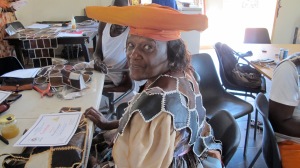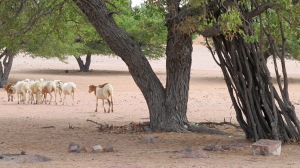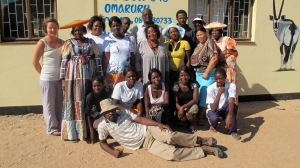 I live in a country that has less people than my hometown in America. Namibia has the second smallest population density in the world. Most people live in the few cities that are scattered across the country, which is size of France and Germany combined. The village and farm communities that surround these cities are in a type of bubble. Somehow these small gems have managed to keep a traditional lifestyle that is lightly weaved with some modern day conveniences; like cell phones and solar panels for power. The first village that I trained in was in the Ohungu Conservancy, about two hours from Omaruru, the nearest city. I stayed at the village hall for fours days leading financial literacy and other small business workshops. Arranging transportation was challenging. I had to carry with me groceries for the week, camping gear, and all the supplies that I would use for the workshop – oh yeah and I had to hitchhike. When I finally arrived to the village hall my trainees were all there waiting to great me. They showed me to a nice spot under an Acacia tree where I set-up my tent and the braai pit (BBQ pit) where I would cook my meals.
I live in a country that has less people than my hometown in America. Namibia has the second smallest population density in the world. Most people live in the few cities that are scattered across the country, which is size of France and Germany combined. The village and farm communities that surround these cities are in a type of bubble. Somehow these small gems have managed to keep a traditional lifestyle that is lightly weaved with some modern day conveniences; like cell phones and solar panels for power. The first village that I trained in was in the Ohungu Conservancy, about two hours from Omaruru, the nearest city. I stayed at the village hall for fours days leading financial literacy and other small business workshops. Arranging transportation was challenging. I had to carry with me groceries for the week, camping gear, and all the supplies that I would use for the workshop – oh yeah and I had to hitchhike. When I finally arrived to the village hall my trainees were all there waiting to great me. They showed me to a nice spot under an Acacia tree where I set-up my tent and the braai pit (BBQ pit) where I would cook my meals. The village hall has two solar panels that powered a deep freeze and -on a very sunny day- my projector. About 100 feet from the hall is a 1,000-liter water container. This is the main water source for the whole conservancy. People walk miles several times a week to fill every empty plastic bottle they can find.Farms surround the village hall. Herds of goat and sheep wonder just beyond the hall fence. The older women in the village wore their traditional dresses with layers of petticoats and cow horn like hats. Teaching this group was difficult. I had young girls maybe 18 and elderly women in there 60’s. Some spoke Otijherero (the language spoken by the Herero tribe), others Afrikaans, and -lucky for me- a few spoke English. I recruited two people from the group to translate for me; with two translators it was difficult to hold people’s attention; two-thirds of the time one group of trainees had no idea what was going on. The class was a success though, the people in my class were so grateful. Aid organizations overlook the small villages and they can’t afford to travel to Omaruru, so they get left out. More than that, I taught them things that no one had ever bothered to explain to them. We talked about how the economy works, and the importance of savings. Some trainees had never thought to look beyond the day or the week. I told them about setting goals and what a SMART goal was.
The village hall has two solar panels that powered a deep freeze and -on a very sunny day- my projector. About 100 feet from the hall is a 1,000-liter water container. This is the main water source for the whole conservancy. People walk miles several times a week to fill every empty plastic bottle they can find.Farms surround the village hall. Herds of goat and sheep wonder just beyond the hall fence. The older women in the village wore their traditional dresses with layers of petticoats and cow horn like hats. Teaching this group was difficult. I had young girls maybe 18 and elderly women in there 60’s. Some spoke Otijherero (the language spoken by the Herero tribe), others Afrikaans, and -lucky for me- a few spoke English. I recruited two people from the group to translate for me; with two translators it was difficult to hold people’s attention; two-thirds of the time one group of trainees had no idea what was going on. The class was a success though, the people in my class were so grateful. Aid organizations overlook the small villages and they can’t afford to travel to Omaruru, so they get left out. More than that, I taught them things that no one had ever bothered to explain to them. We talked about how the economy works, and the importance of savings. Some trainees had never thought to look beyond the day or the week. I told them about setting goals and what a SMART goal was.  It was an ah-ha moment for many. I could see it on their face when they told me they asked if they could set a goal to build a house or finish school. To have the audacity to see beyond the year was not common.
It was an ah-ha moment for many. I could see it on their face when they told me they asked if they could set a goal to build a house or finish school. To have the audacity to see beyond the year was not common. Namibia never fails to amaze me. In a secluded village hours away from the bustle of modern living was a group of farm owners, shopkeepers, teachers and craftsmen. They struggled but they coped. After the course they now have some new ideas on how to write a budget or keep track of stock, hopefully to make life a little easier.
Namibia never fails to amaze me. In a secluded village hours away from the bustle of modern living was a group of farm owners, shopkeepers, teachers and craftsmen. They struggled but they coped. After the course they now have some new ideas on how to write a budget or keep track of stock, hopefully to make life a little easier.
- Comment
- Reblog
-
Subscribe
Subscribed
Already have a WordPress.com account? Log in now.